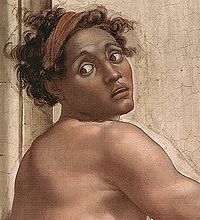
Giornata
Encyclopedia

Buon fresco
Buon fresco is a fresco painting technique in which alkaline resistant pigments, ground in water, are applied to plaster when it is still wet, as opposed to fresco-secco...
mural painting and describes how much painting can be done in a single day of painting. Knowing how much can be painted in a day is crucial in the Buon fresco technique, because in this technique a watercolor paint, without binder, is applied to wet lime plaster
Lime plaster
Lime plaster is type of plaster composed of hydrated lime, sand and water. Lime plaster is similar to Lime mortar, the main difference is the based on use rather than composition. Traditional lime plaster contains also horse hair to reinforce plaster....
which binds the paint into the surface of the plaster when it dries, making for an extremely durable painting. An experienced fresco painter knows how much surface can be painted in a day, and wet plaster is applied to the wall in the right amount needed for each day's work. That amount is the giornata. Generally the plaster is applied in a way that will conform to the outline of a figure, or object, in a painting, so that the daily segments will not show, but it is occasionally visible as different sections in a work where the artist may not have been able to replicate a pigment exactly the next day, or where restoration has altered or made apparent the changes in pigment between the sections.
Notable examples giornate

Masaccio
Masaccio , born Tommaso di Ser Giovanni di Simone, was the first great painter of the Quattrocento period of the Italian Renaissance. According to Vasari, Masaccio was the best painter of his generation because of his skill at recreating lifelike figures and movements as well as a convincing sense...
's Expulsion from Eden - It is clearly visible that the figures of Adam and Eve were painted separately from the rest of the image, and indeed that the two figures themselves were painted separately from each other.

